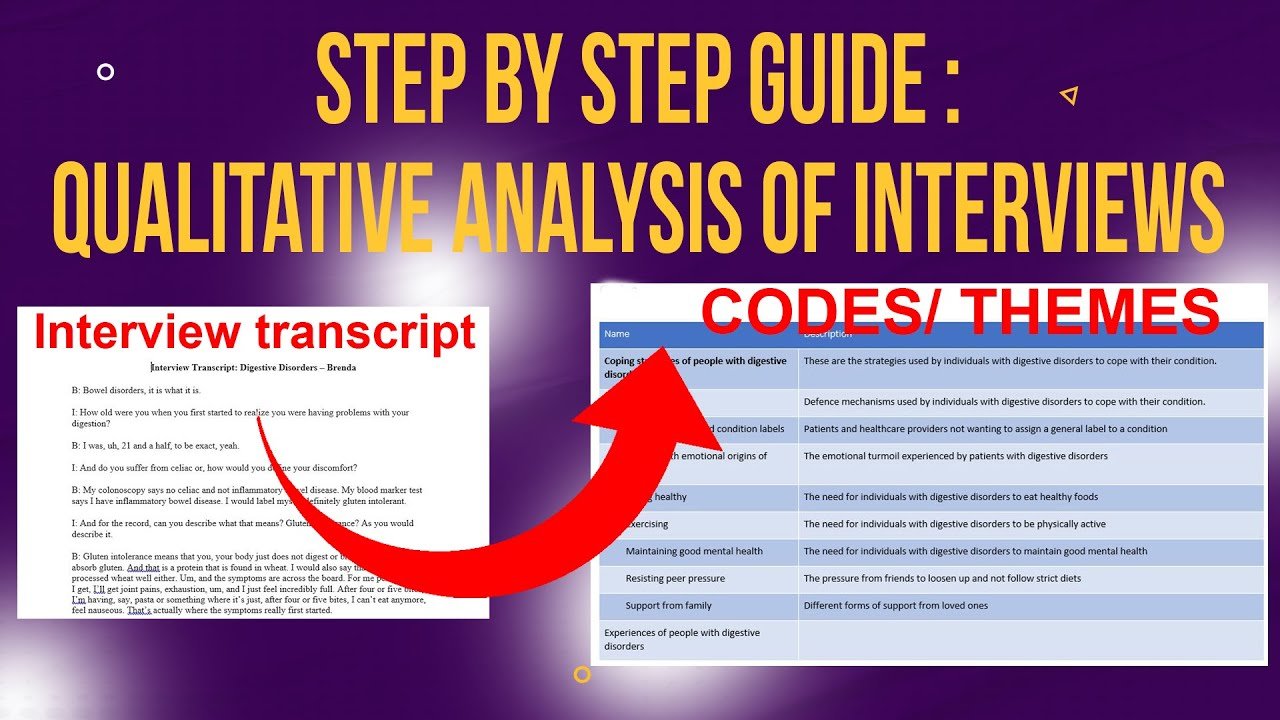Thematic Analysis of Focus Group Data using Nvivo
In this article, we are going to learn how to find themes in focus groups.
First, let’s understand what a focus group is. Focus groups are used to collect qualitative data by asking a group of people about their attitudes or feelings towards a product, service, concept, advertisement, or idea.
Questions are asked in an interactive group setting where participants are free to talk with other group members.
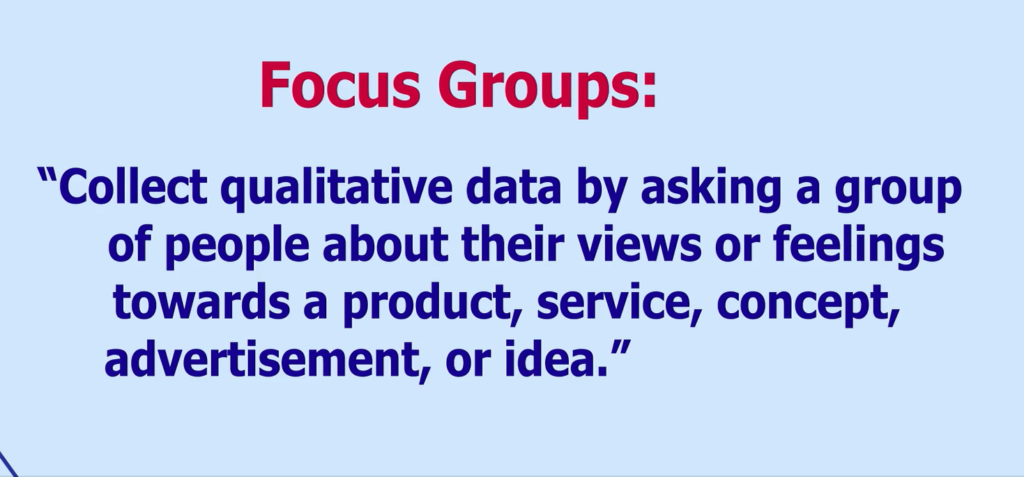
In this article, I will utilize a theoretically flexible approach to conduct thematic analysis on a focus group, which is the Brown and Clark six step approach for thematic analysis.
This is a majorly inductive approach to thematic analysis.
In inductive thematic analysis, the researcher analyses the data to get patterns of shared meaning which are interpreted and labelled as codes.
Eventually, the shared meaning in codes helps in the development of the themes.

In contrast, the deductive thematic analysis approach involves having predetermined themes that are developed before the analysis, what is referred to as a priori, and then trying to fit data or codes into the already predetermined themes.

Generally, thematic analysis is an ideal approach to analyse qualitative data when one is trying to find out about:
- People’s views.
- Opinions.
- Experiences.
- Assess people’s knowledge about a given topic.
- Assess people’s values or beliefs.
- Explore questions about how people interpret their experiences and the meanings they attach to them.
For instance, in this study, the focus group I will be analyzing explores different experiences of people diagnosed with atrial fibrillations in Sao Paulo, Brazil.
The six steps I’m going to follow in conducting thematic analysis on a focus group will include:
- Familiarizing with the focus group,
- Generating initial codes.
- Coming up with themes.
- Reviewing and refining themes.
- Providing clear descriptions to the themes.
- Writing the findings report.
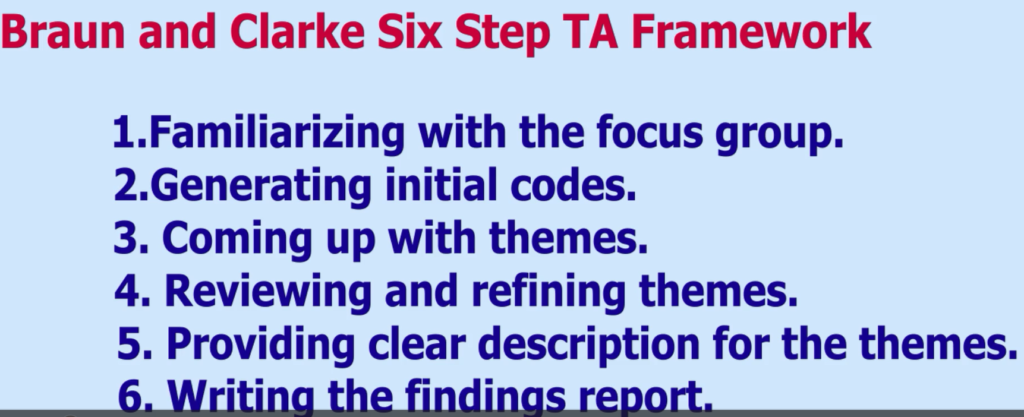
Familiarizing with the Focus Group

I’m going to go through the first step of conducting thematic analysis through the Brown and Clark framework, which is familiarizing with the focus group.
The first thing that I should note down is that the focus group, include discussions conducted in Sao Paulo, Brazil, with people diagnosed with atrial fibrillation.
So, these are people with a certain type of heart condition.
To familiarize myself with this, what I’ll do is just read through this focus group like a story, I won’t skip anything because I want to understand the context of these interviews and to see the tone of the interviewee, the tone of the interviewer, how the interviewee responds to different questions related to the study topic, which is atrial fibrillation.
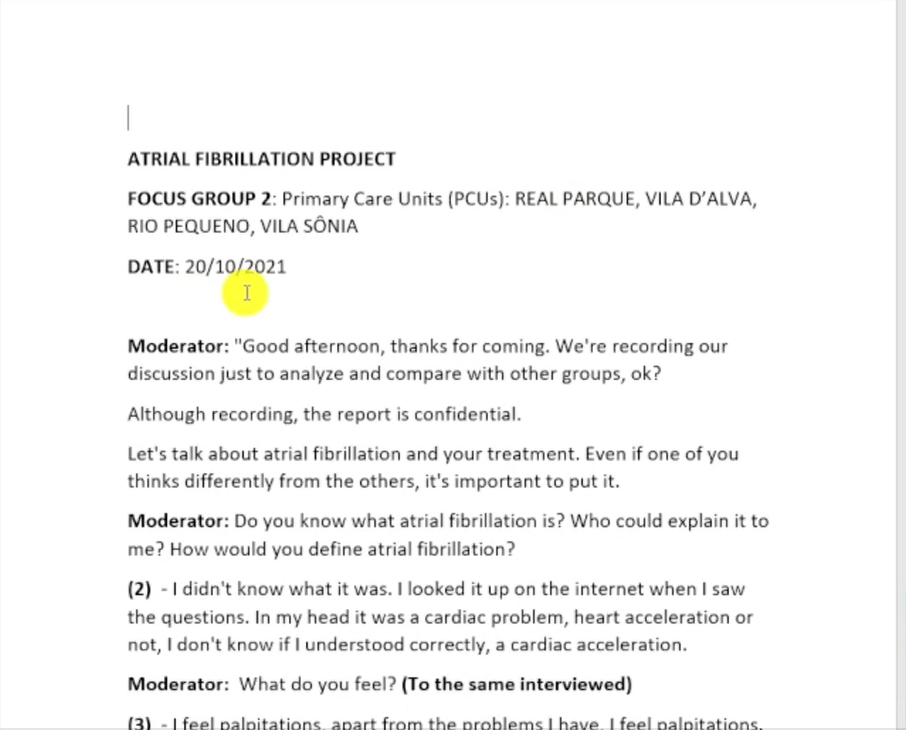
I will read through all this, to familiarize adequately with the transcript in a way that I can be able to come up with codes from this.
Generating Initial Codes

Now, after familiarizing with the transcript, I will go to the next step which is generating initial codes. Now let’s look at how I generate initial codes.
And to generate initial codes, I will need to first. Just import this focus group into Nvivo. So, let’s do that quickly
.
We are going to create a new project and call this FG analysis, focus group analysis.
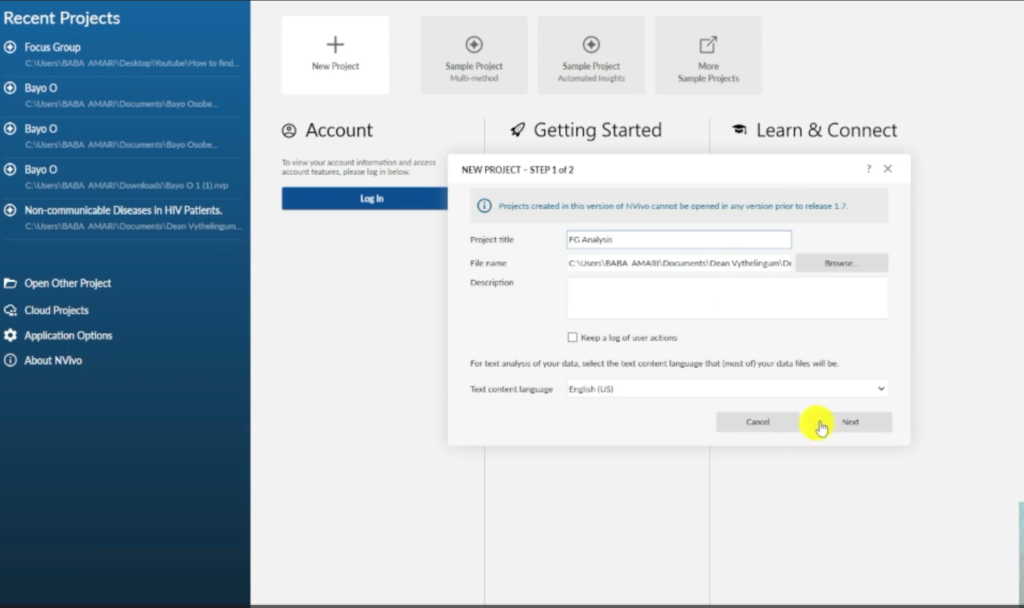
Then click on next.
I want to display save reminder every 15 minutes I don’t want to autosave the project because and Nvivo can lose your progress so every 15 minutes I’m going to have a save reminder.

The next thing that I want to remind you is that when you open Nvivo, especially if you are a beginner, just ignore all these menus. We have the top menu and this blue menu.
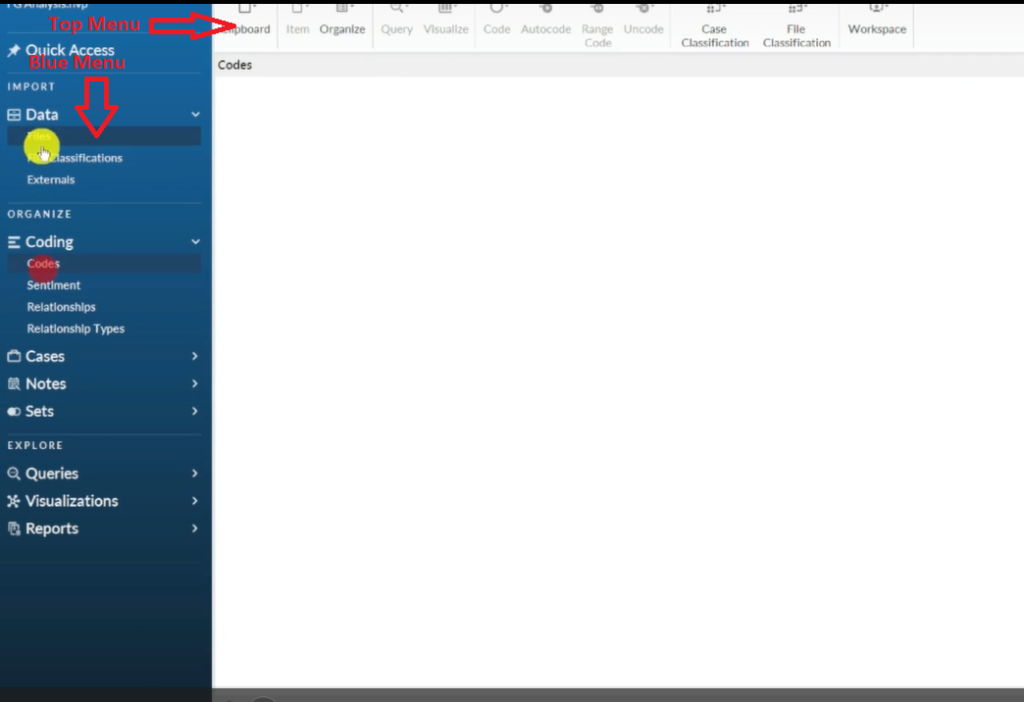
Just focus on the files and the code section in the blue menu.
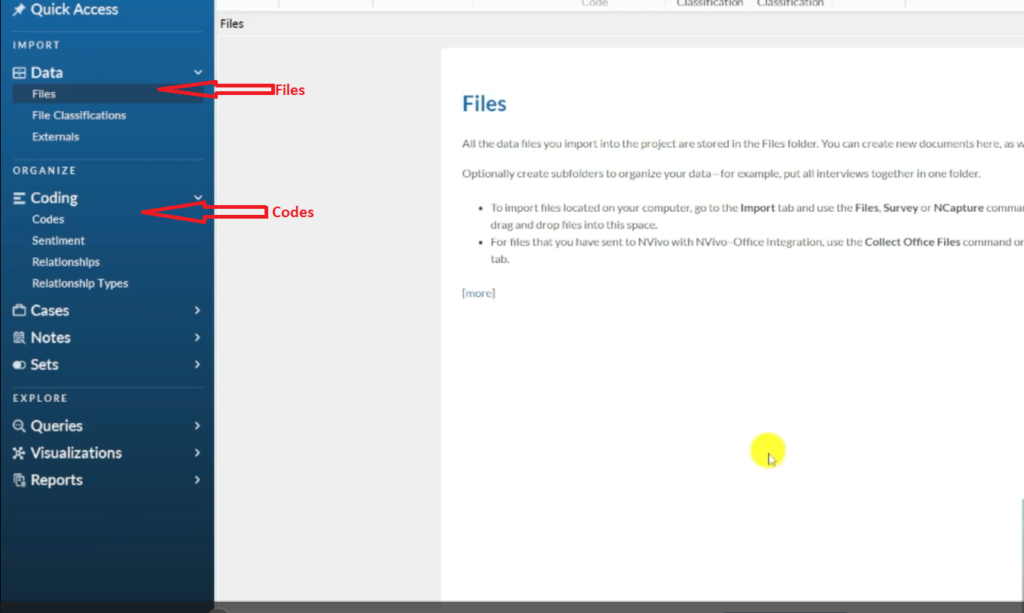
We are going to import our focus group in the files section, and we are going to develop codes at this section.
To import, we drag and drop the focus group in the files section.
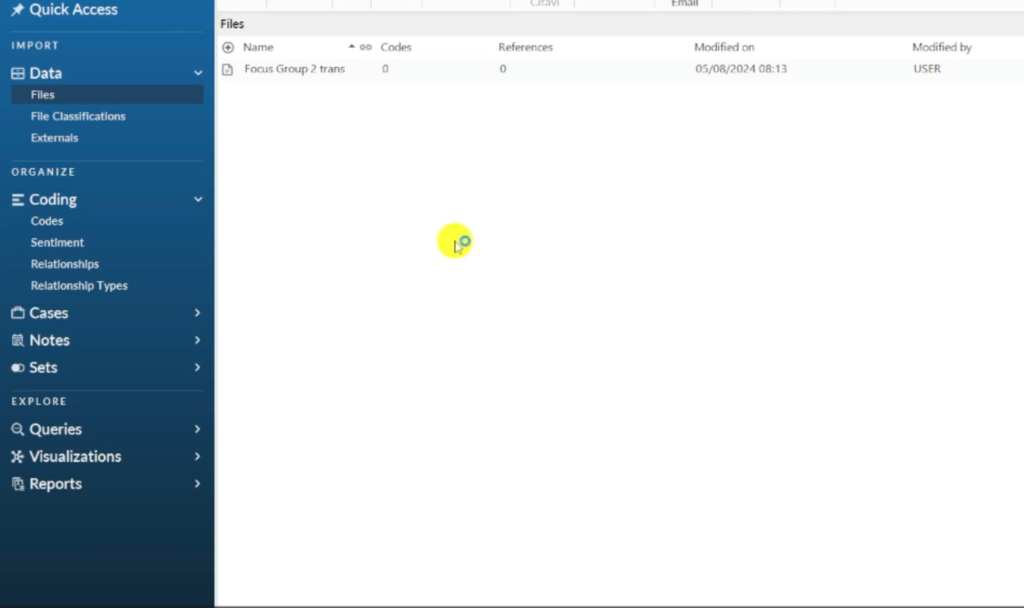
Remember, this is a focus group that was conducted on people suffering from atrial fibrillation, which is a kind of a heart condition,
And now we are going to start generating initial codes.
This is the transcript. I’ve opened it. I’m going to generate initial codes.
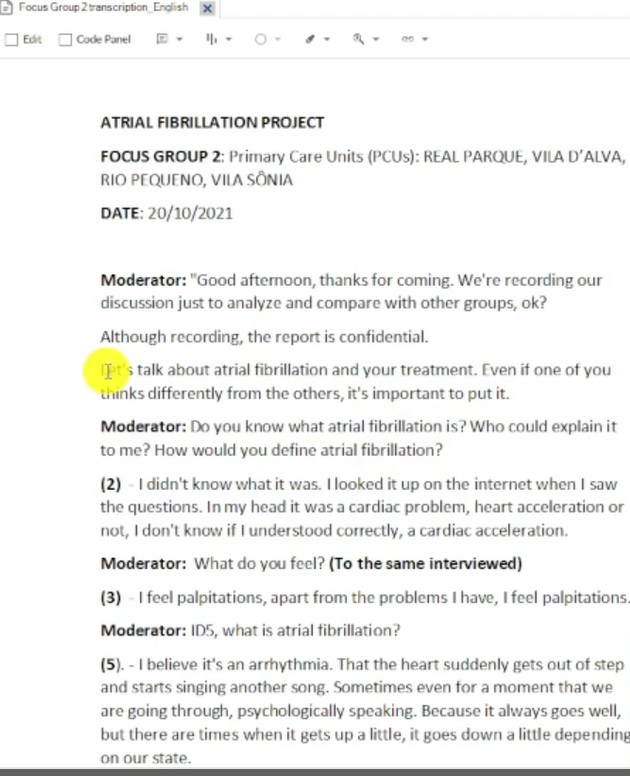
Let’s generate some initial codes.
So, we can see the moderator saying “good afternoon, thanks for coming. We are recording our discussion just to analyse and compare with other groups, although recording, the report is confidential. Let’s talk about atrial fibrillation and your treatment.
Even if one of you thinks differently from others, it’s important to put it. Do you know what atrial fibrillation is? Who could explain to me? How would you define atrial fibrillation?“
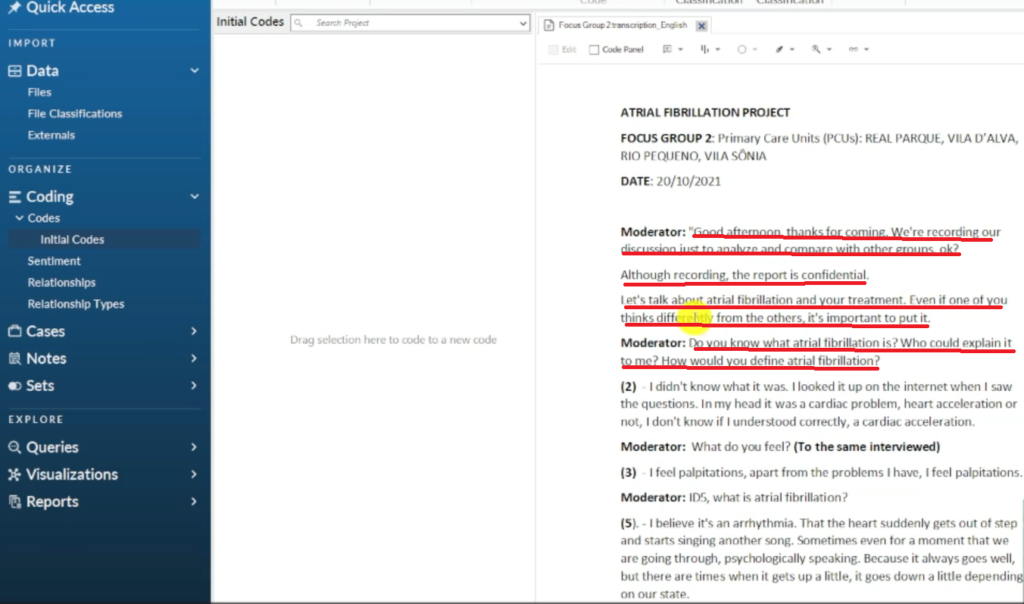
So that’s the first question that the moderator asks the participants of the focus group.
We are going to code the answers to the question
“I didn’t know what it is. I looked it up on the internet when I saw the questions in my head. It was a cardiac problem. Heart acceleration or not. I don’t know if I understood correctly.“
A cardiac acceleration.”
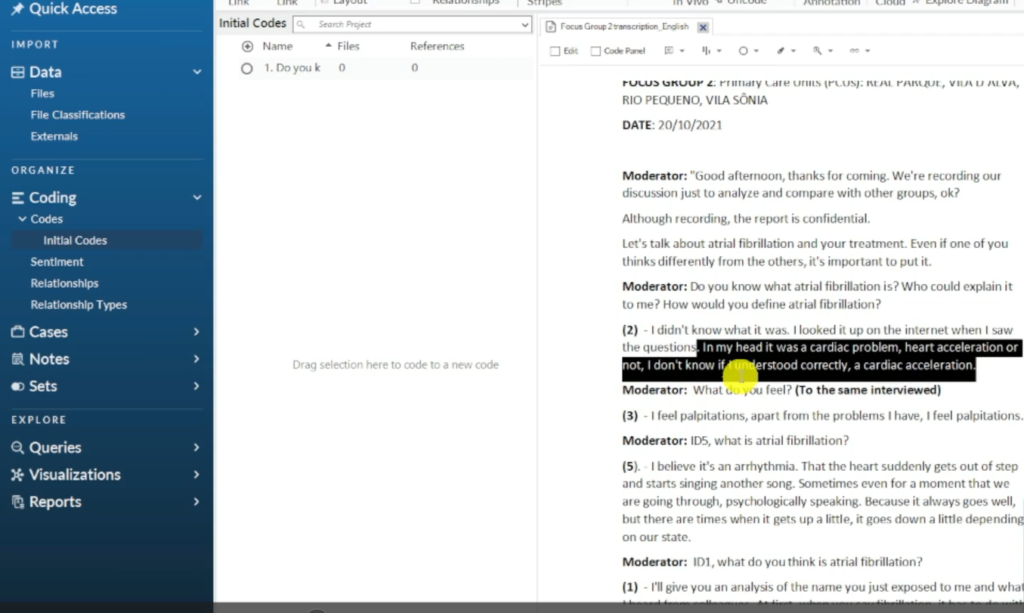
So, to this person, they define atrial fibrillation as a cardiac acceleration.
We create a code called cardiac acceleration
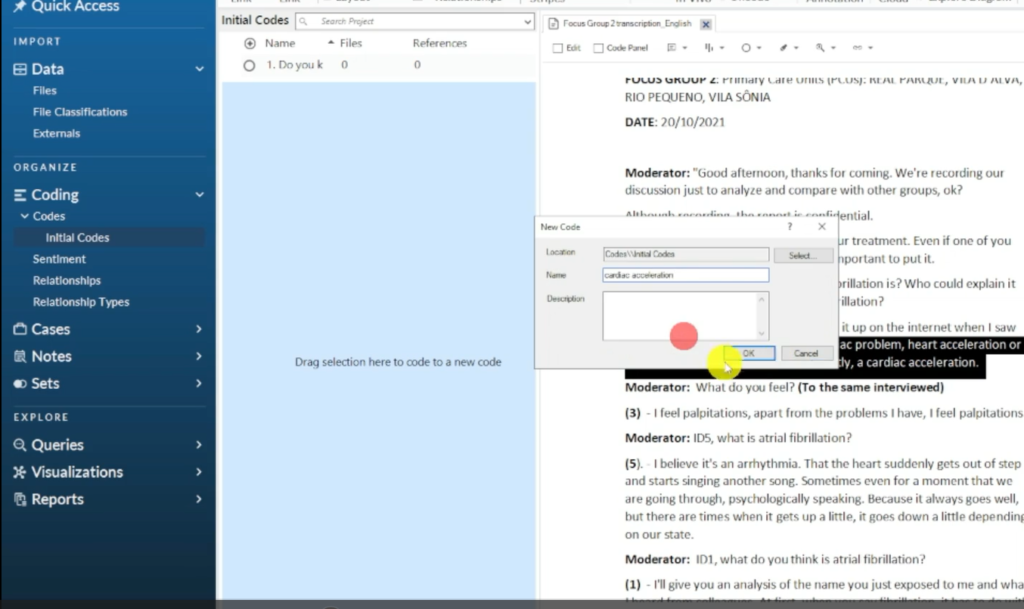
I want to define what a code is. A code is a label or an interpretive statement to information.
Or a section of information provided by participants, which is important to our research objectives or research question.
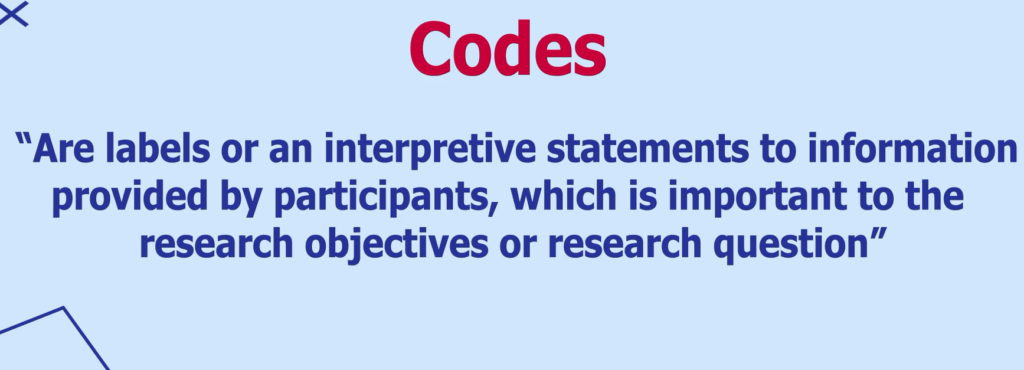
Basically, when we are coding, we are just labelling or tagging important sections of information that will be important or that answers our research question or fulfils our research objectives.
Let’s see a second code so that you may understand what I’m doing.
So what is arterial fibrillation? “I believe it’s arrhythmia. The heart suddenly gets out of step and starts singing another song. Sometimes, Even for a moment that we are going through psychologically speaking, because it always goes well, but there are times when it goes up a little, it goes down a little, depending on our state.“
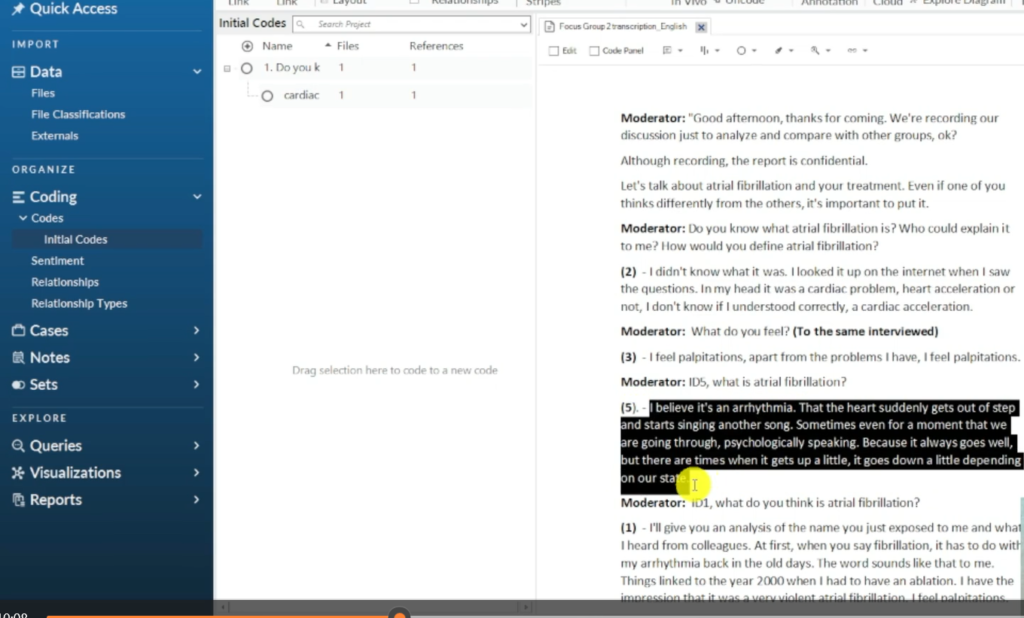
So, this person can, we can quote this whole section, and this person believes, or defines, artery of fibrillation as what? As arrhythmia. I highlight this section, drag and drop it in the codes section, and call that code arrhythmia.
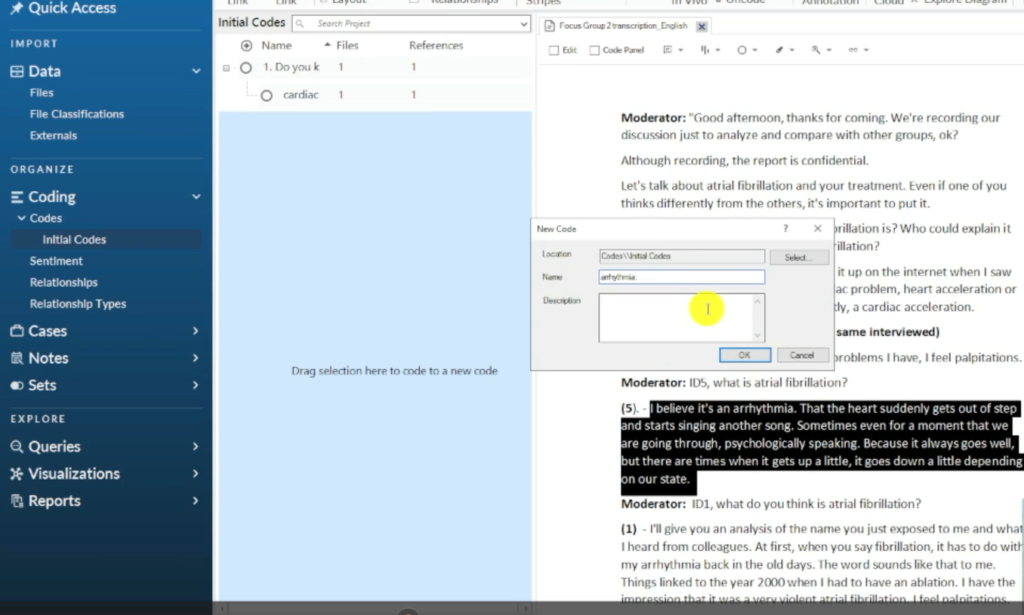
Remember, coding is labels or interpretive statements to particular information that’s important to our research objectives.
Let’s have another code.
What do you think is atrial fibrillation? “I’ll give you an analysis of the name you just exposed to me and what I heard from colleagues.
At first, when you say fibrillation, it has to do with my arrhythmia back in the old days. The word sounds like that to me. This link links to the year 2000 when I have to have an ablation. I have impression that this is very violent atrial fibrillation. I feel palpitations apart from the problems I have.“
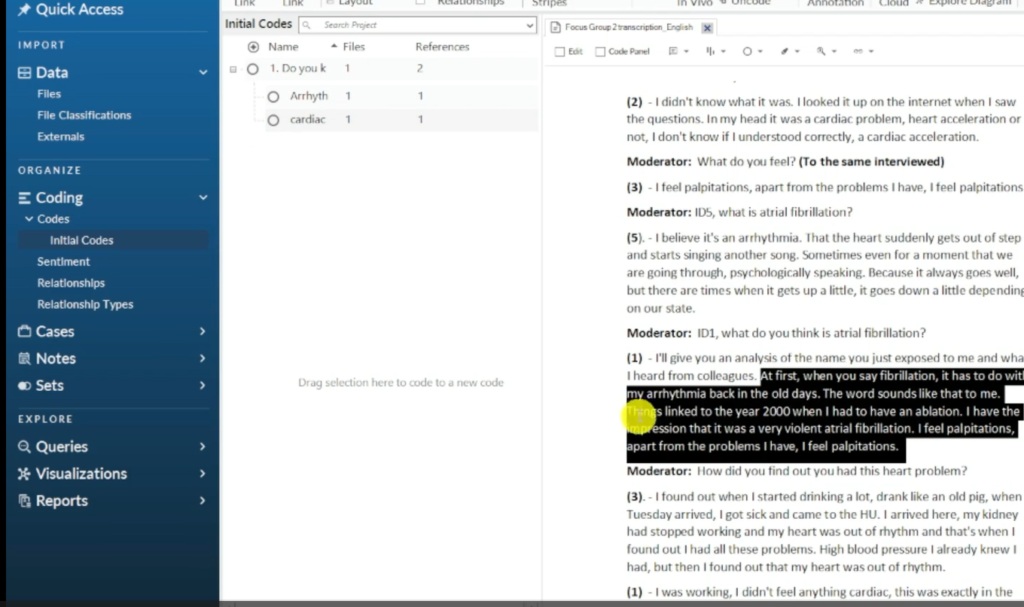
I feel palpitations. So this person believes that atrial fibrillation, has to do with arrhythmia also, so, when we have a similar or the same code.
what we do is drag and drop this under a previous code we had already developed of arrhythmia.
Now, the moderator asks another question. How did you find out you had this heart problem?
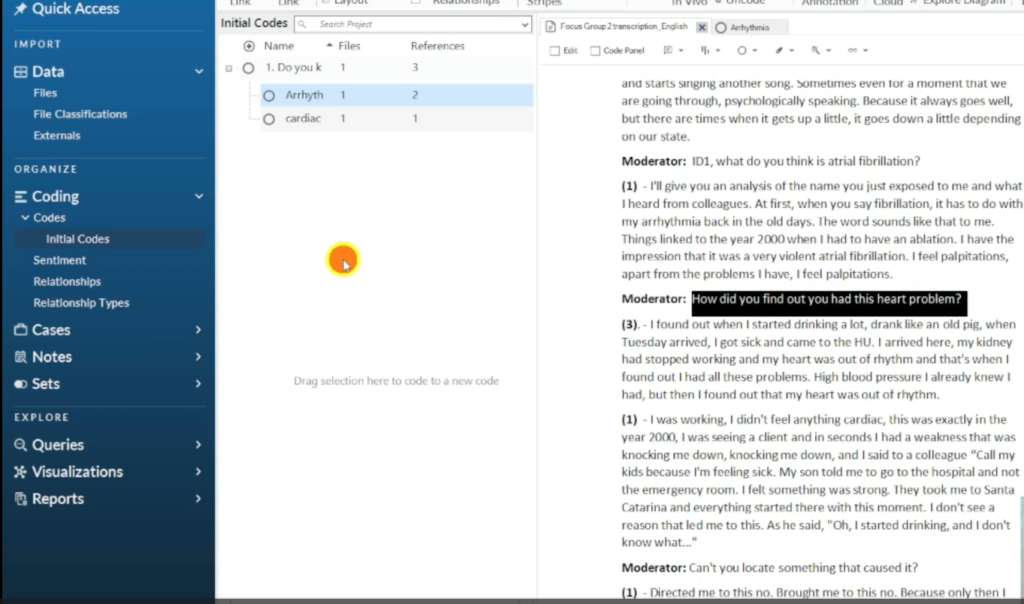
Let’s keep coding.
“How did you find out that you had this heart problem? “”I found out when I started drinking a lot. Drunk like an old pig when Tuesdays arrived. I got sick and came to the HU. I got sick and came to the HU. I arrived here, my kidney has stopped working, and my heart was out of rhythm.
And that’s when I found out I had these problems. High blood pressure I already knew I had, but then I found that my heart was out of rhythm.“
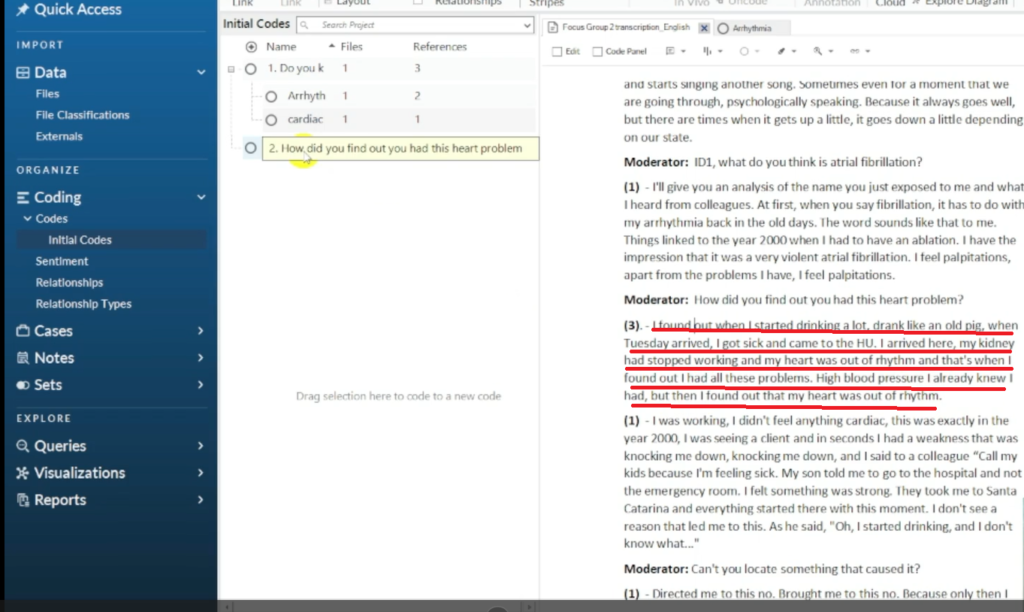
So only this statement, we can code this as, Diagnosed in a healthcare facility.
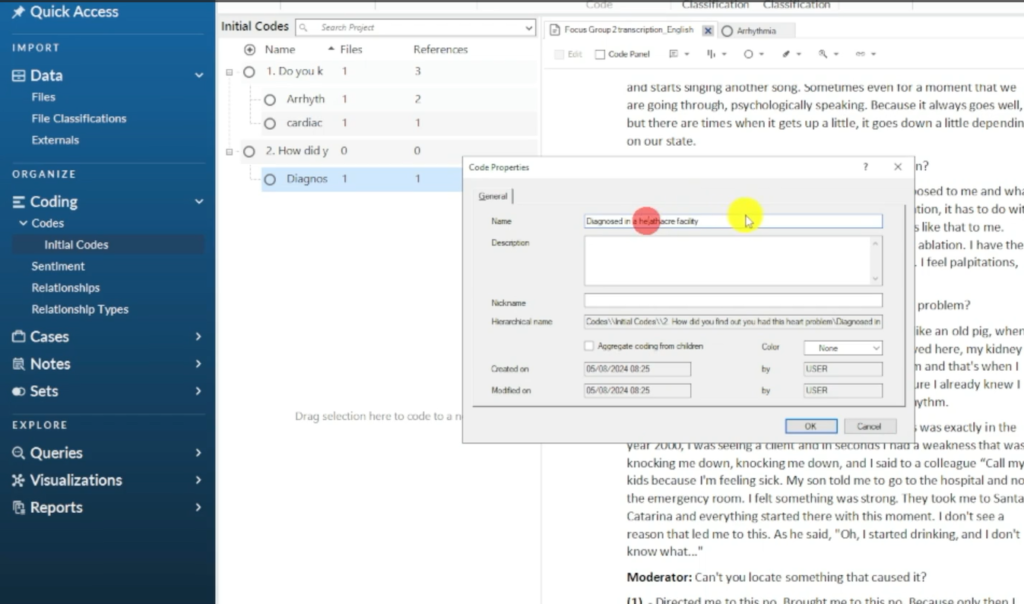
Let’s keep going. Let’s see another participant.
“I was working, I didn’t feel anything cardiac. This was exactly in the year 2000. I was seeing a client, and in seconds, I had a weakness that was knocking me down. And I said to a colleague, Call my kids because I’m feeling sick. My son told me to go to hospital and the emergency room. I felt something was wrong.
They took me to Santa Catarina and everything started there with this movement. I don’t see a reason that led to this. As he said, oh, I started drinking and I don’t know what.“
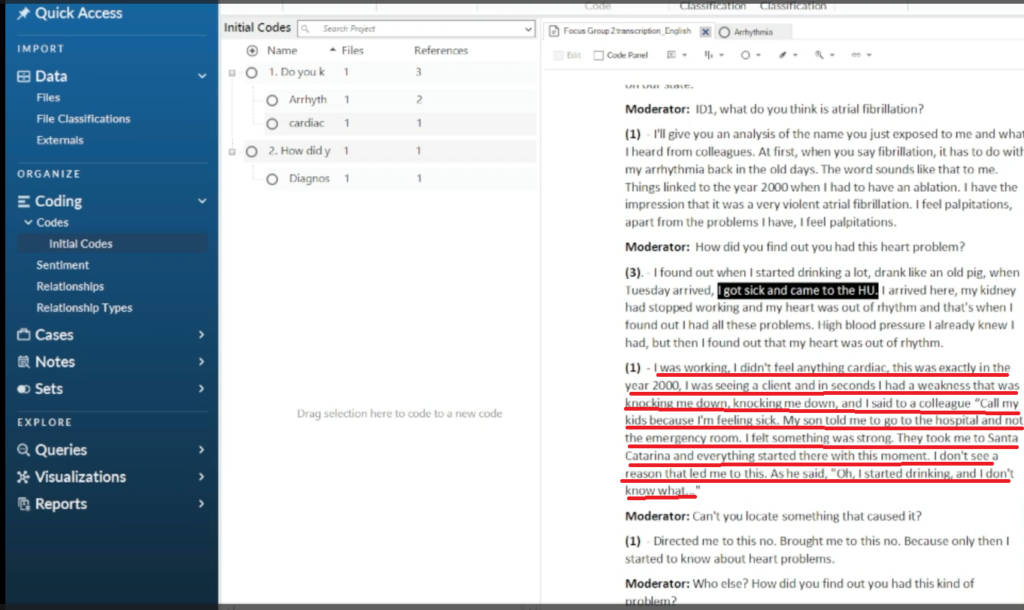
So how did you find out you had this heart problem?
Let’s code this. Again, we can drag, drop, or we can right click, go to code selection, and just select here. I want a new child code.
We can say, Experienced weakness in the workplace and was taken to the emergency room.
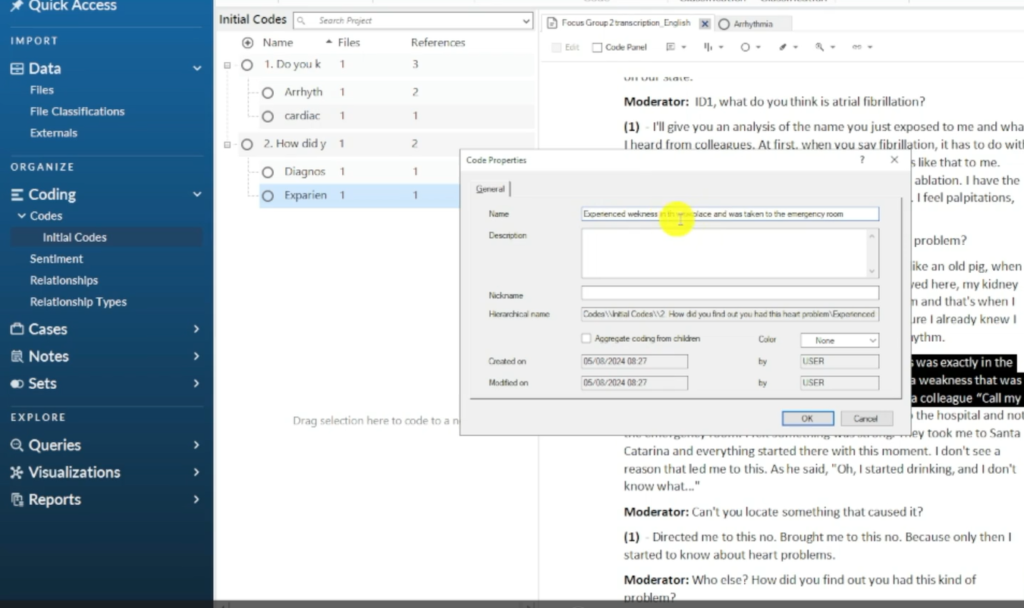
So that’s another code
Let’s again review the codes we are creating codes and the codes are interpretive statements or labels of information that’s important to our research question.
Let’s continue coding.
“How did you find out you had this kind of a problem?” This one is related to how did you find out you had this heart problem. So, this participant 2 says ,”At the age of 18, I discovered that I had alterations in my heart. I went for an exam for work, and the doctor said I had to take a look at these alterations.“
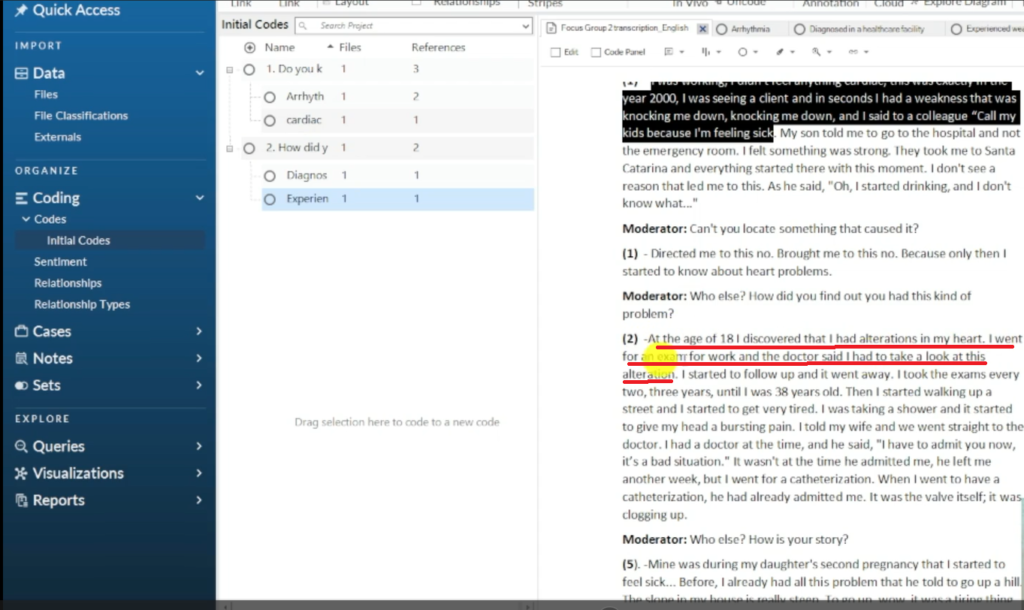
So, this one, how did you, remember the question? The questions help us to get the right codes. How did you find out you had this problem?
So, during a scheduled health examination at work. I want to go to code selection, select number two, and now let’s call this during a scheduled health examination in the workplace.
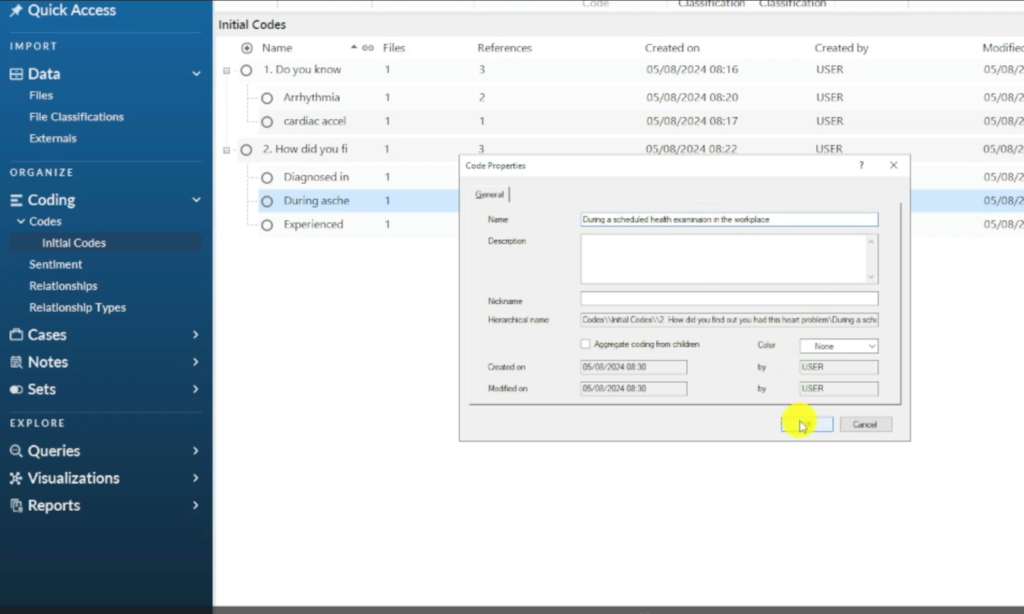
I want you to notice something about the codes that I’m making.
You can see some of my codes are sentences, some of them are few words. Some of them are one word. Five words, a whole sentence, okay?
Now, when you are coding, a code can be one word, two words, three words, that doesn’t matter, as long as the code is accurate.
So, the code has to be an accurate interpretation of the interview or the focus group data. This is how we generate initial codes in a focus group. So I will go through the whole focus group and generate codes.
So that’s how we generate initial codes, which is the second step of the Brown and Clark six step framework for thematic analysis, which is the approach we are using to get themes in this focus group.
Now I have taken my time to go through the whole focus group and do the initial coding.
And these are my initial codes. For example, how do you define atrial fibrillation? You can see some say it’s a cardiac problem, an arrhythmia, heart acceleration, heart palpitations.
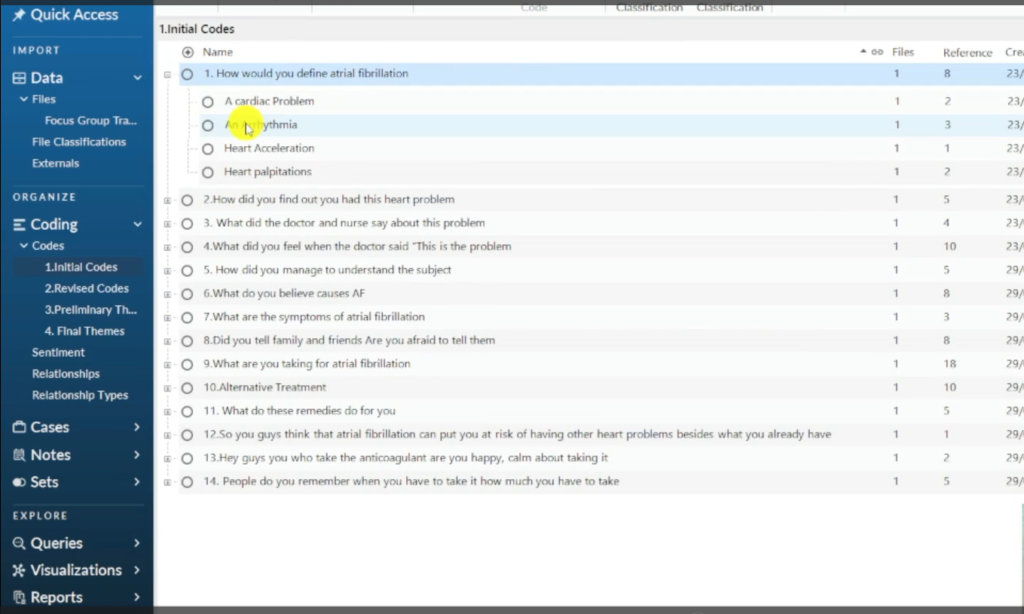
What do you believe causes atrial fibrillation? Others are saying smoking. Then being born with bicuspid valve, have no idea, drinking excessive weight, getting rheumatic fever as a child. So, we have so many causes of arterial fibrillation, according to the participants in the focus group.
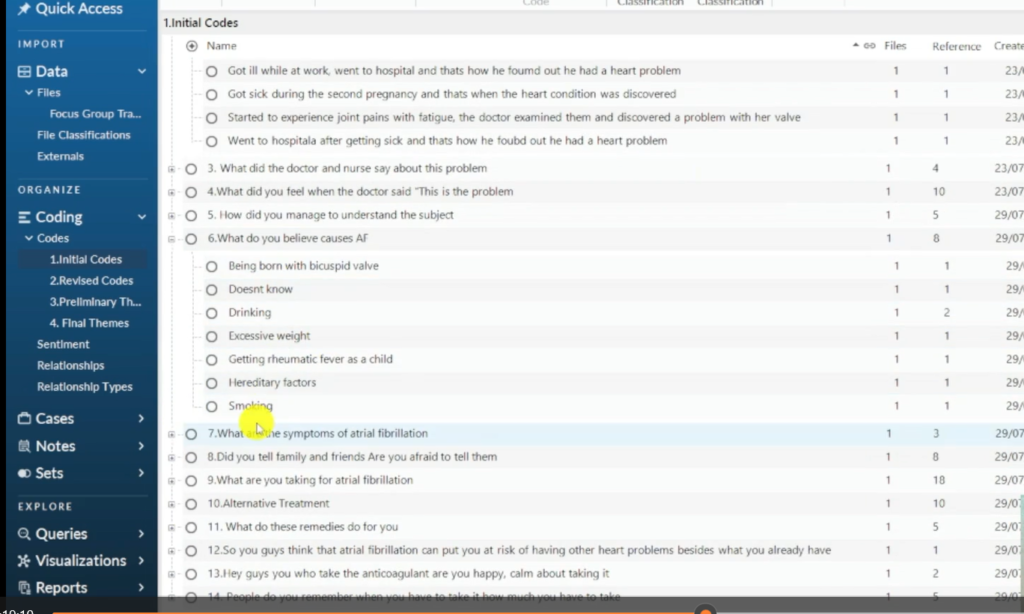
So, basically, in the initial coding, you can see what I’m doing is capturing the questions, okay, the questions the moderator is asking, then adding the codes below the questions, which are the answers, as I just showed you previously.
Now, we are going to revise these codes. By revising we mean, going and right clicking and going to code properties.
We rename and re edit the codes, and then, if there are codes that have shared meaning, we combine them.
Generating Initial Themes
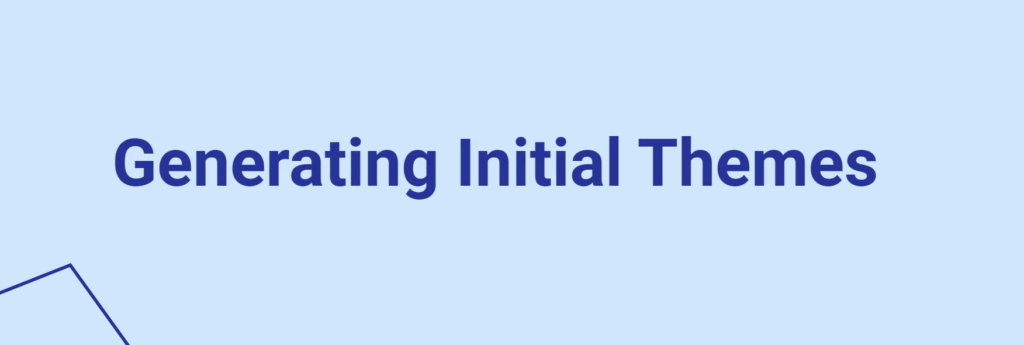
Now, after generating the initial codes for the whole focus group, and revising the codes, as you can see here, I can move to the third step of the Braun and Clark six step framework for thematic analysis, which is generating initial themes.
Initial themes are also known as preliminary themes.
So how do we do that? Let me show you. What we do is, now we start looking at the meaning that the researcher wanted to find out when asking given question. Now, for shared meaning between different issues we’ll combine those shared meanings between different issues to form themes.
For example, how would you define atrial fibrillation? If you right click and go to code Properties, we can add a description here and say,
How the participants defined atrial fibrillation, AF.
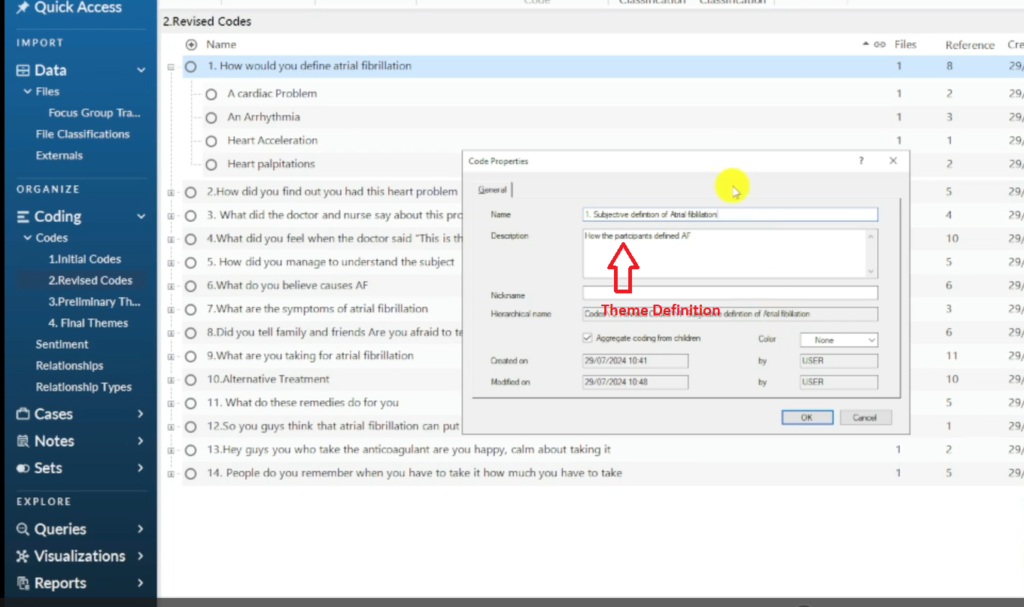
So, again now I will edit this from a question into how would you define atrial fibrillation.
We can name this subjective definition of atrial fibrillation.
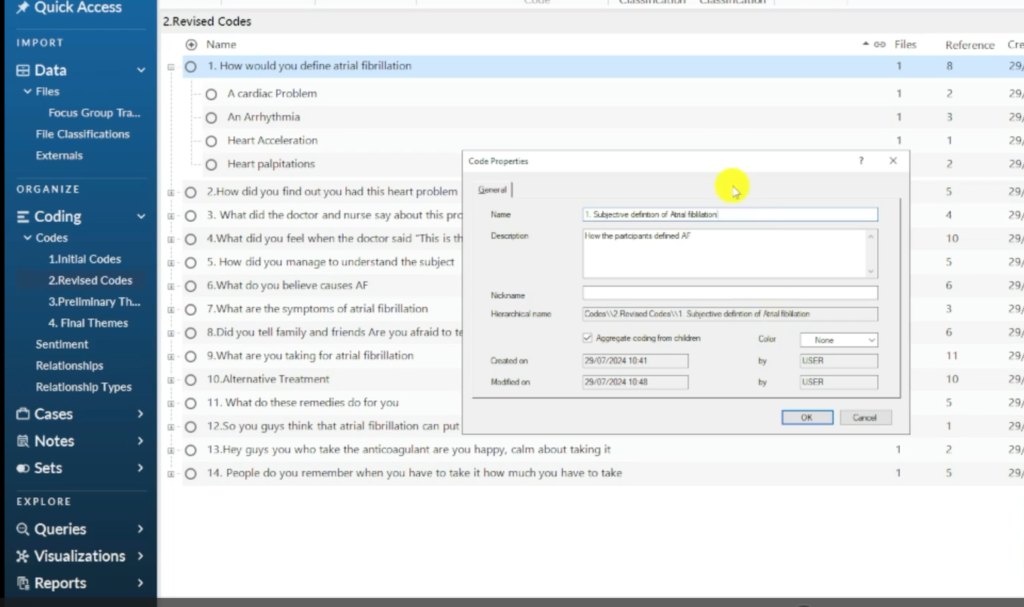
So, that’s how we revise codes to start coming up with preliminary themes.
Let’s look at another one. Based on shared pattern of meaning, for example, what do you believe causes AF?
Remember, these were my initial questions, and I was using them as containers to contain the codes. Now I’m revising them, and sometimes, I’m going to even combine the codes to form subthemes.
So what do you believe causes AF? So, the causes, I’m adding the description here, so, I’m right clicking, go to code properties, and call this the causes of atrial fibrillation according to the participants.
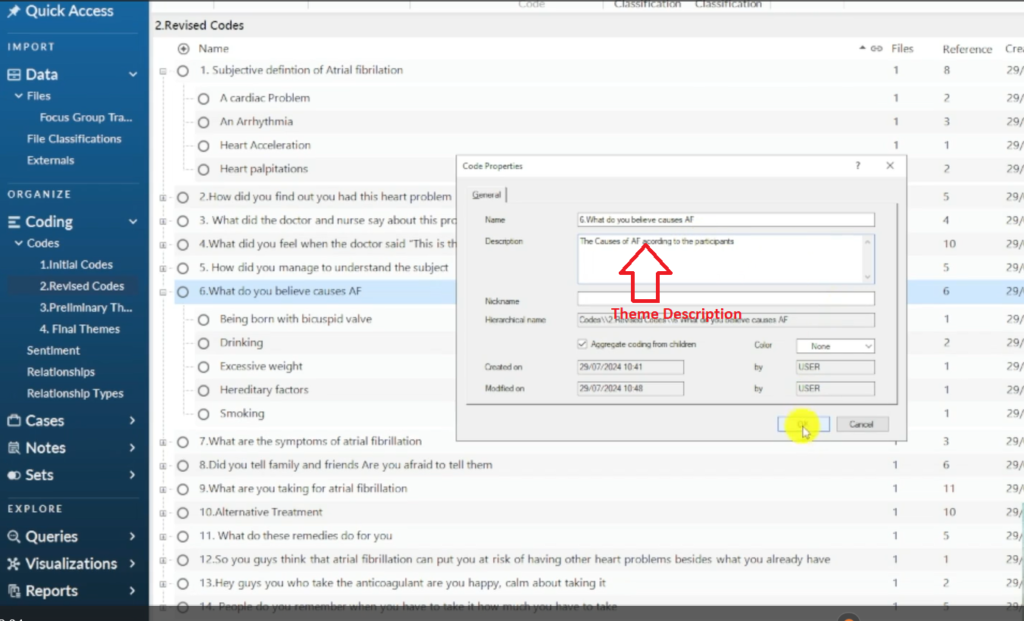
So that’s just a description. I still want to edit now this one. What do you believe causes AF?
So this one can be causes of AF.

You can see I’ve started getting some preliminary themes which I can combine.
Then you can see what are the symptoms of atrial fibrillation. That’s a question they were asked, or the moderator asked the participants in the focus group. Again, if we go to code properties, we can say
The symptoms of AF According to the participants,
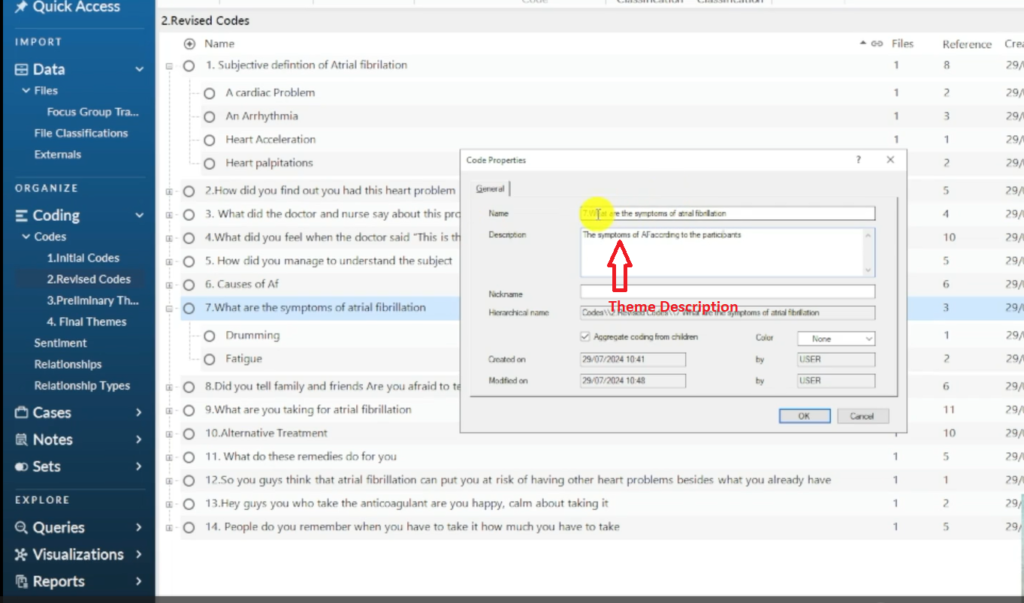
And then, what are the symptoms of atrial fibrillation can become? Symptoms of atrial fibrillation.
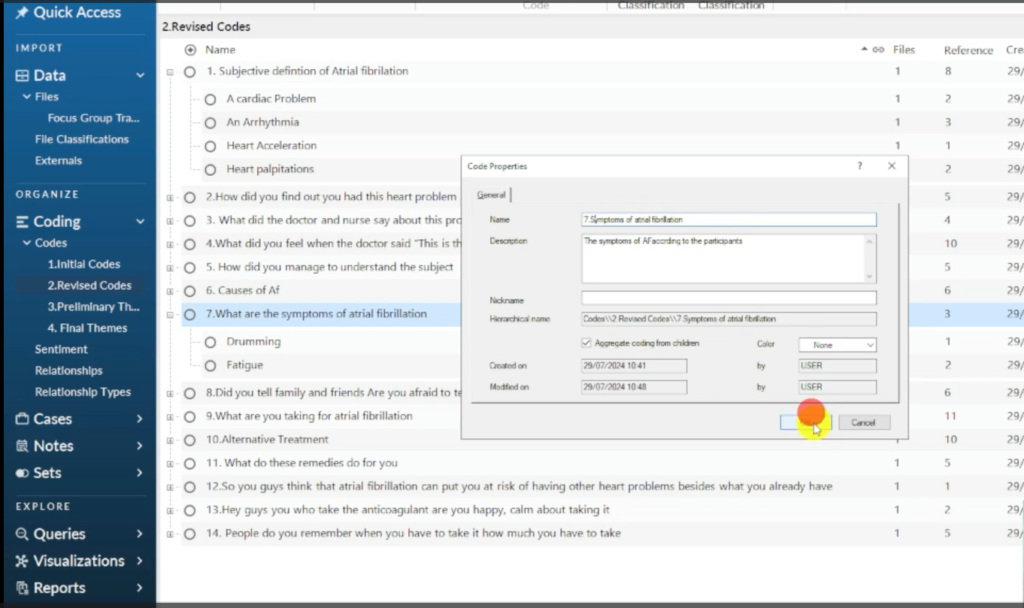
So that’s how you develop themes.
Reviewing and Refining Themes

Now let’s look at the fourth step of the Brown and Clark six step framework for thematic analysis, which is reviewing and refining
It’s a matter of going in to my preliminary themes after I formulated all of them and looking if there is a pattern of shared meaning between the codes to form subthemes.
If there is a pattern of shared meaning, you create subthemes and combine the subthemes to form themes.

Now, the fifth step of the Brown and Clark framework of thematic analysis is defining and naming themes. So that means for every theme, I’ll go right click, go to code properties. You can see I’ve already added the definition and descriptions.
For example, atrial fibrillation definition. We can see the description is how atrial fibrillation is defined by the participants and the medical staff.
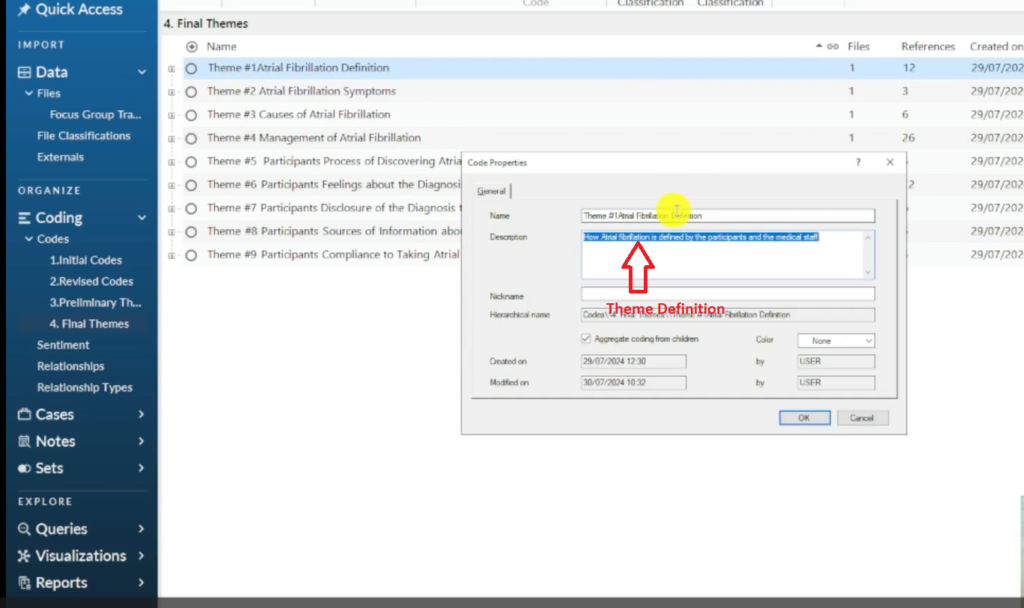
Then, atrial fibrillation symptoms, if you right click, you can see I added a description. The symptoms of atrial fibrillation according to the participants.
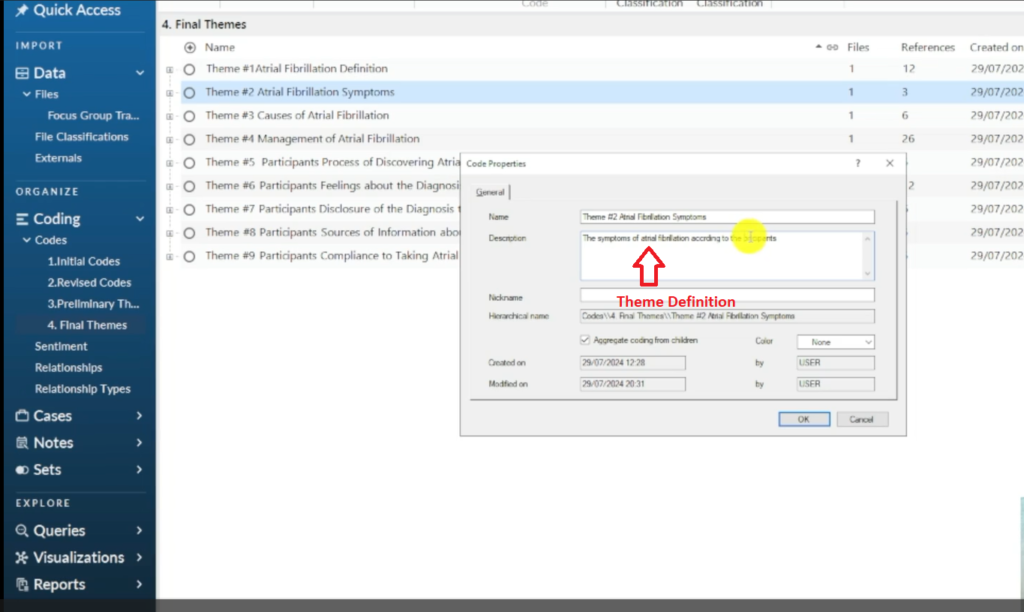
So, we have to go theme by theme, right click, go to code properties and clearly define the theme for a third party who would want to understand.
So, I added descriptions for all these themes.
And after defining and naming themes, I can go to share, go to export, export code book, and I want to export this code book. For you to see right now. And you can see, I can get a code book that includes my final themes and clear descriptions of what these themes mean. So, every final theme has a clear description of what it means.
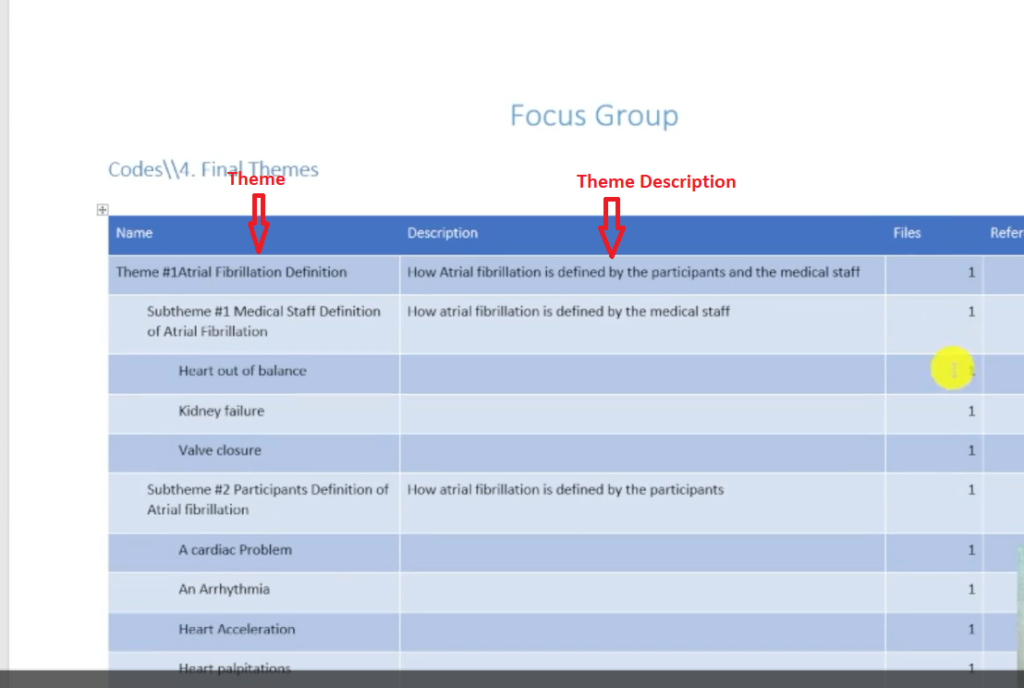
Writing the Findings Report

I went and wrote findings report related to the analysis I conducted with the focus group.
So, you can see the first part of the data analysis report is me describing the approach I used to provide or to produce themes from the focus group.
Which is the Braun and Clark six step framework for thematic analysis. And these are the six steps, and we have gone through them one by one. I’ve also said that I used Nvivo to manage the data.
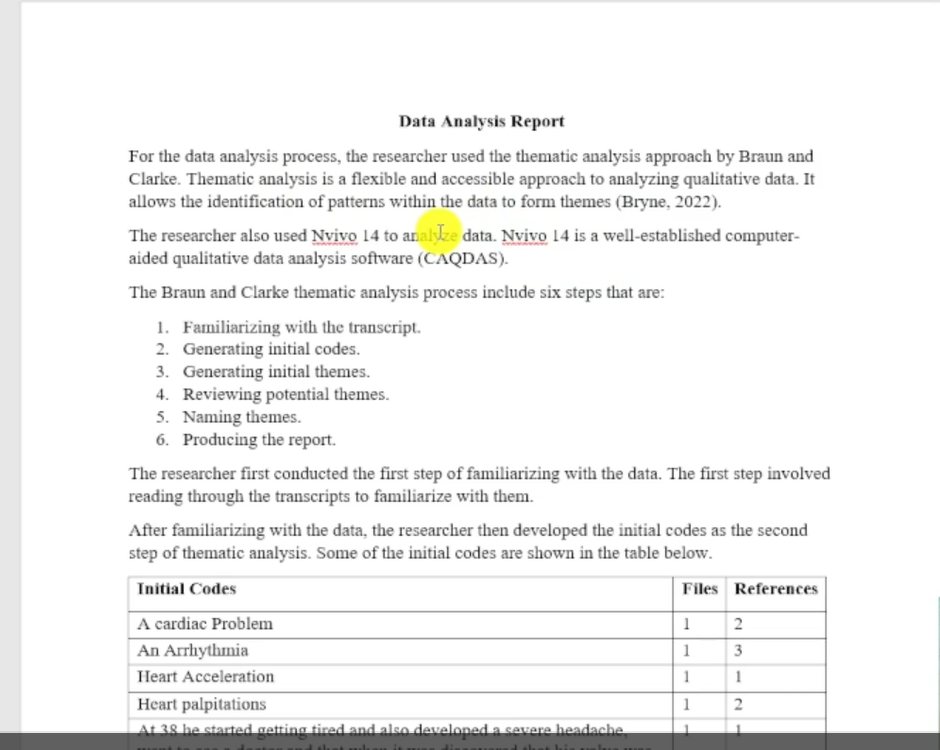
You can also see my report has kind of tables.
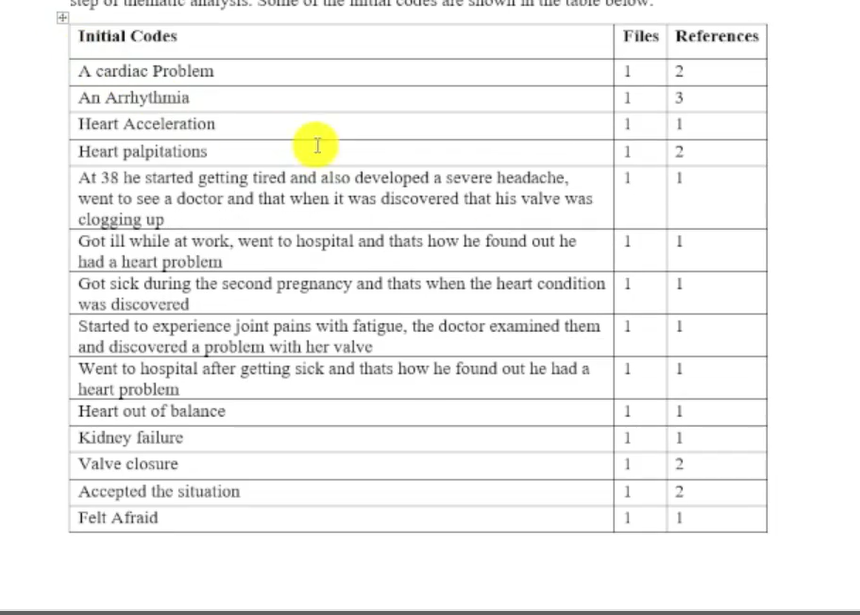
And these tables, I obtained them from simply pressing Ctrl A on my final themes folder and then going to export, export list.
And I export an Excel and let me show you the Excel. This is the Excel that I got.
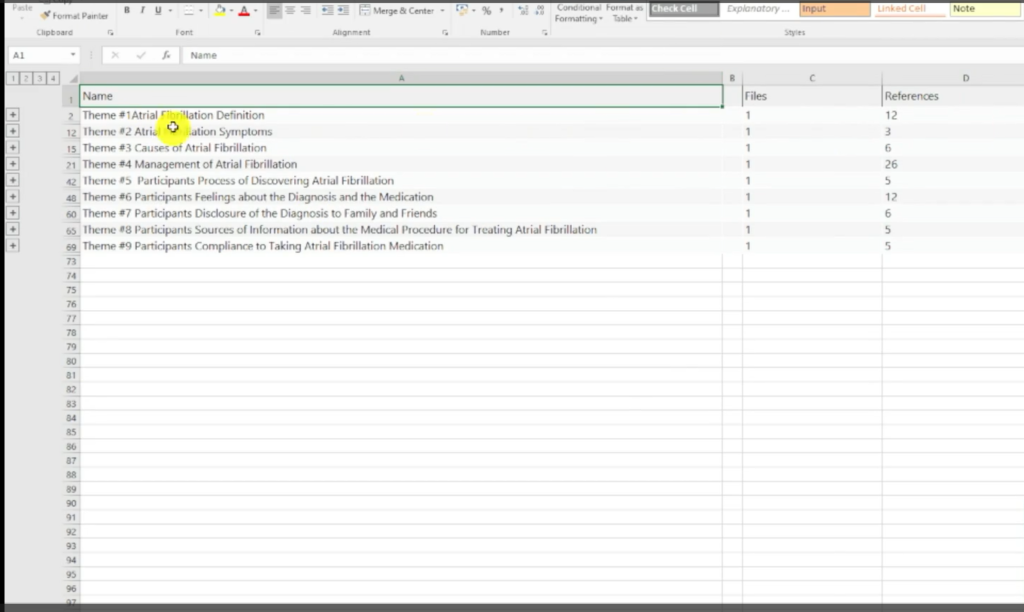
The findings report includes all the themes that I found when analysing the focus group, and how prominent they were and their story, the sub themes under them, the codes under them, and trying to interpret what the participants meant or by providing different opinions on the issue of discussion or the study topic.
So basically, I wrote all that report, and there’s a visual I did there. This is called a hierarchy chart.
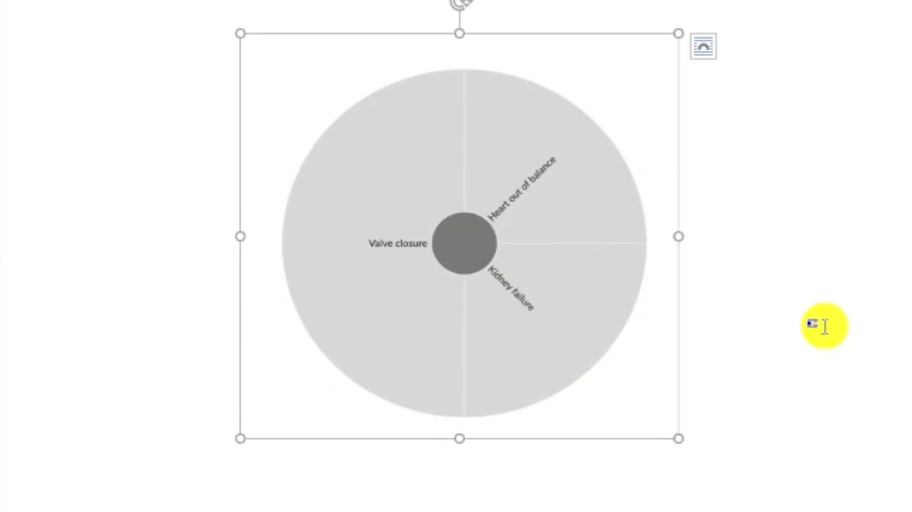
Another visual I included in the report is a mind map as shown below.
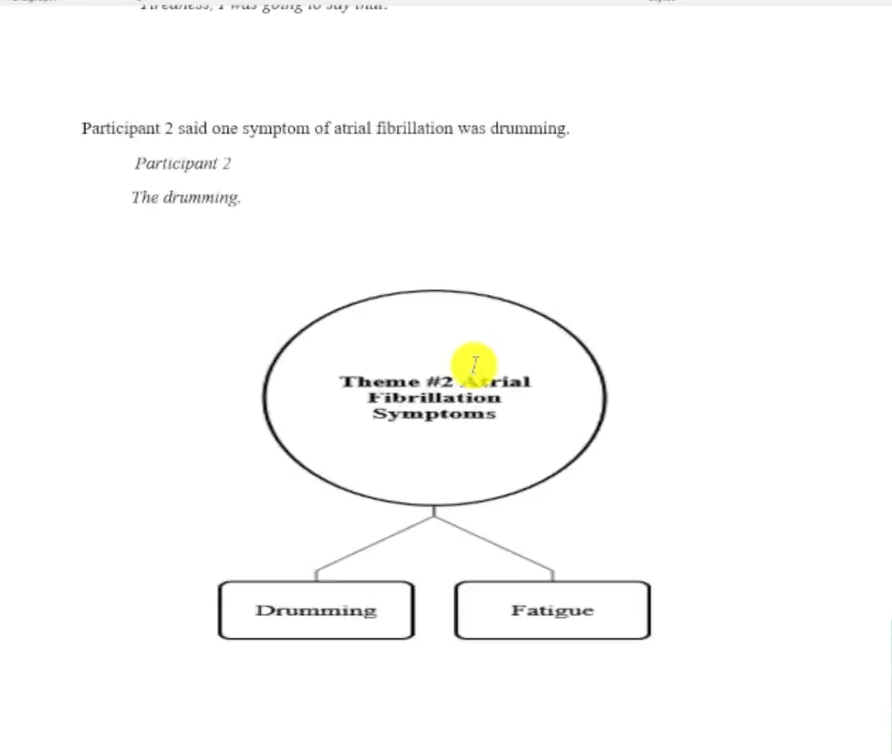
For more information on how to visualize click here 9 Ways to Visualize Your Results in Nvivo.
So basically, the findings report is explaining the findings and how they came about, how we developed the themes, how we developed the sub themes, and then getting some visuals such as the hierarchy chart, tables, and mind maps to make our report more interesting.
To access the entire report, click here Findings Report.
